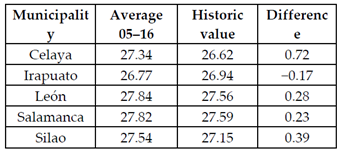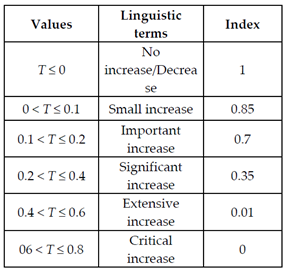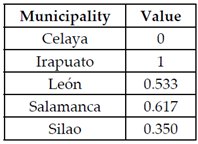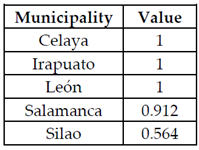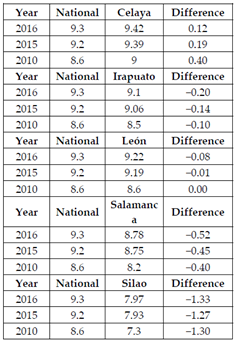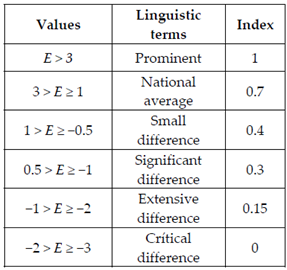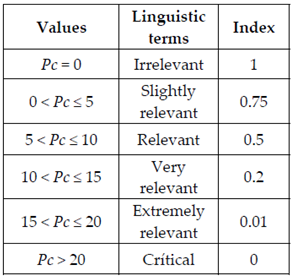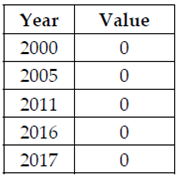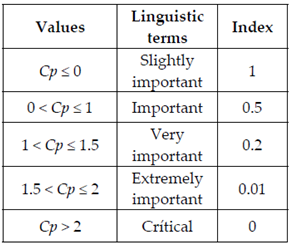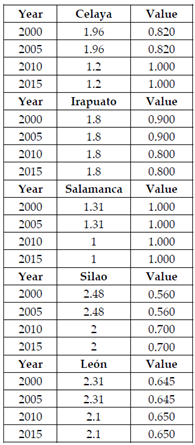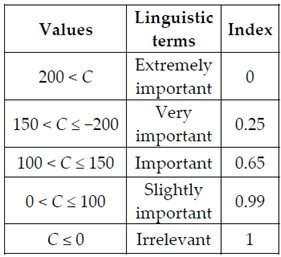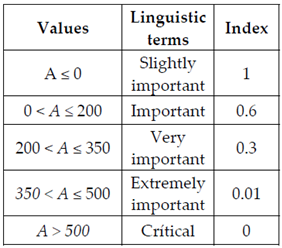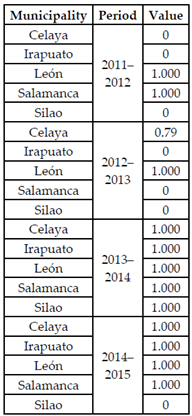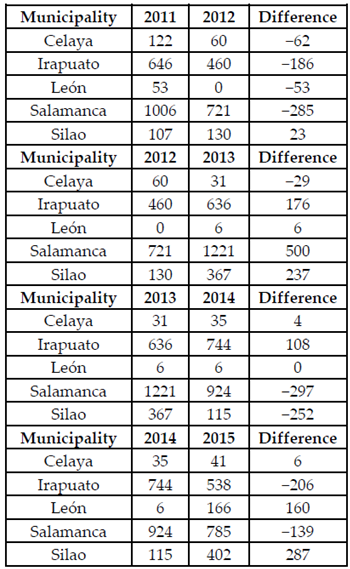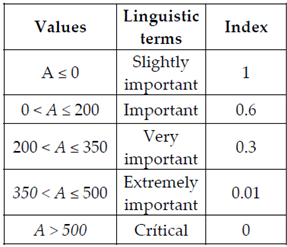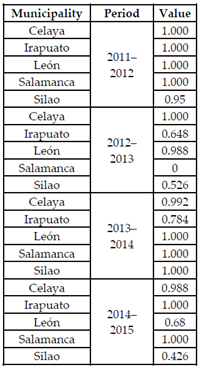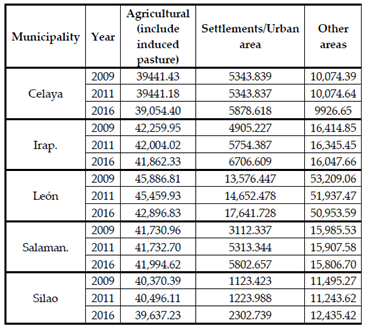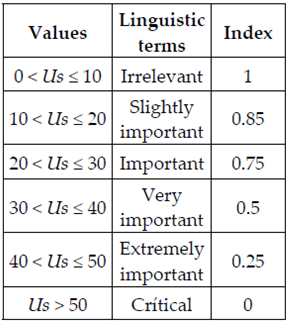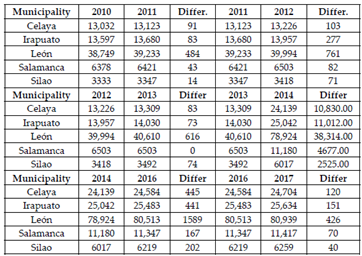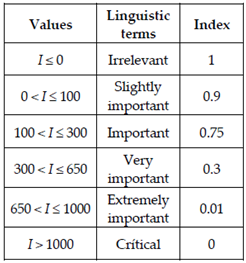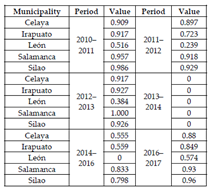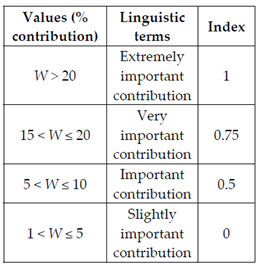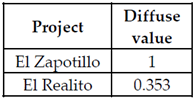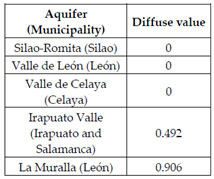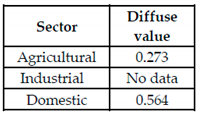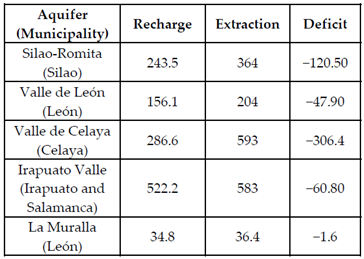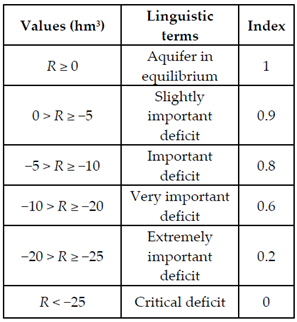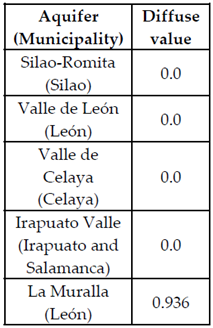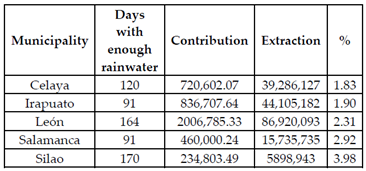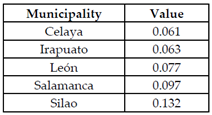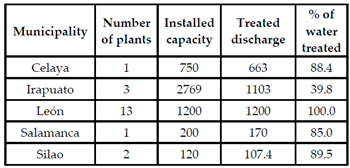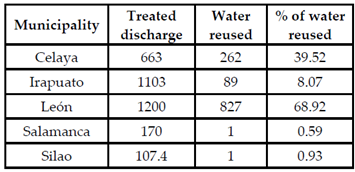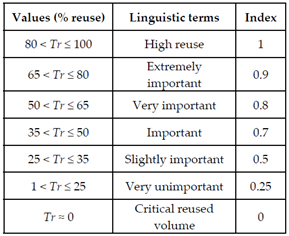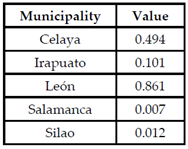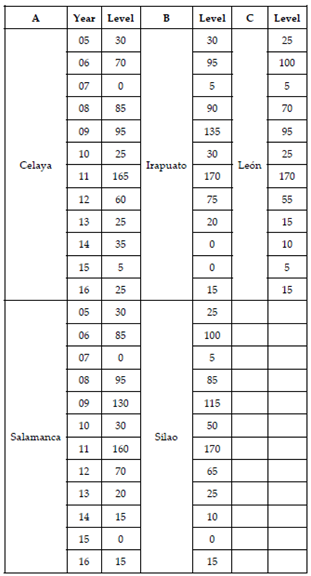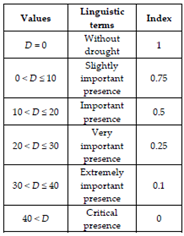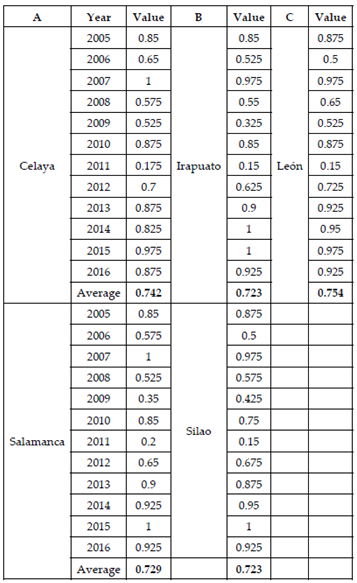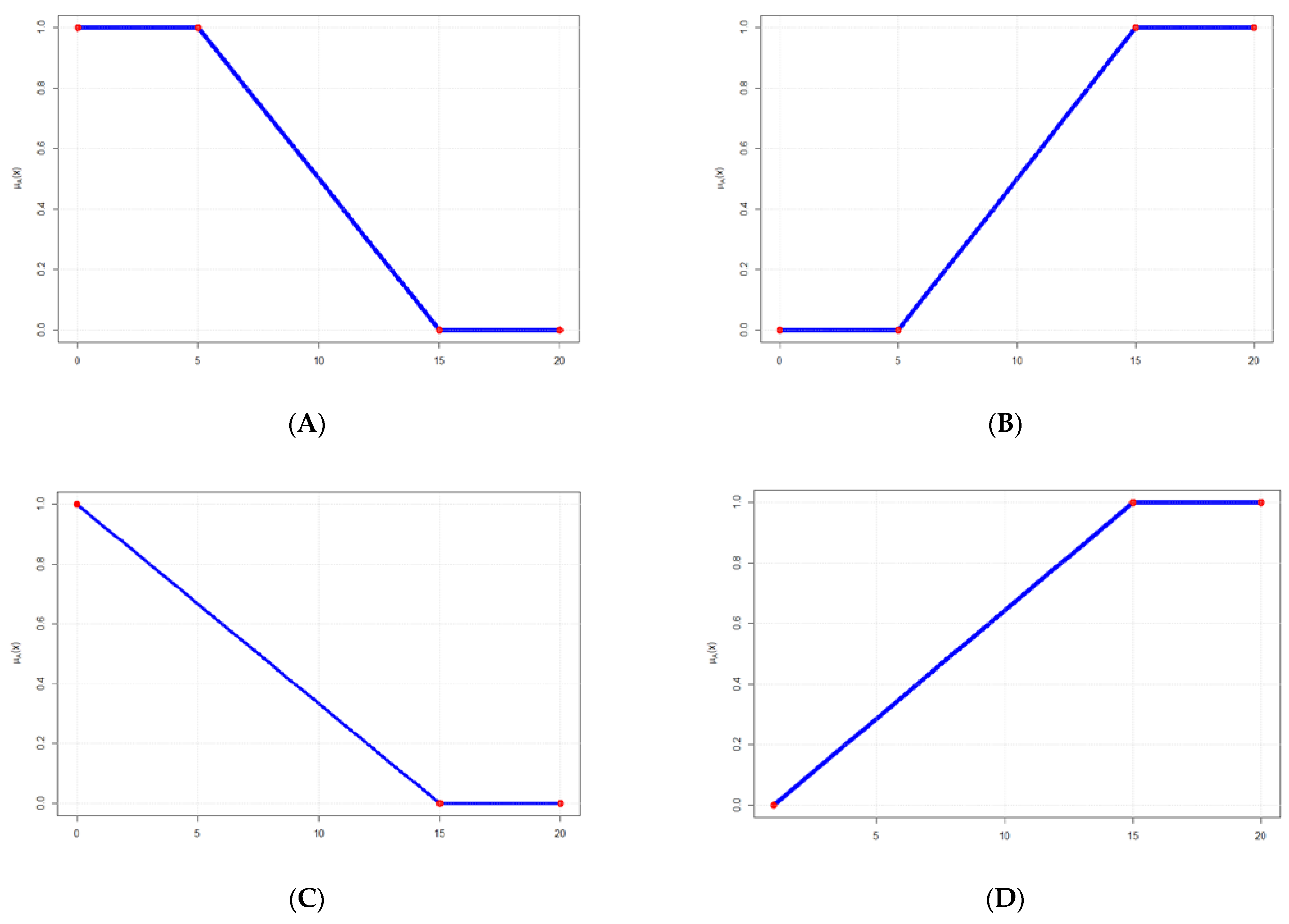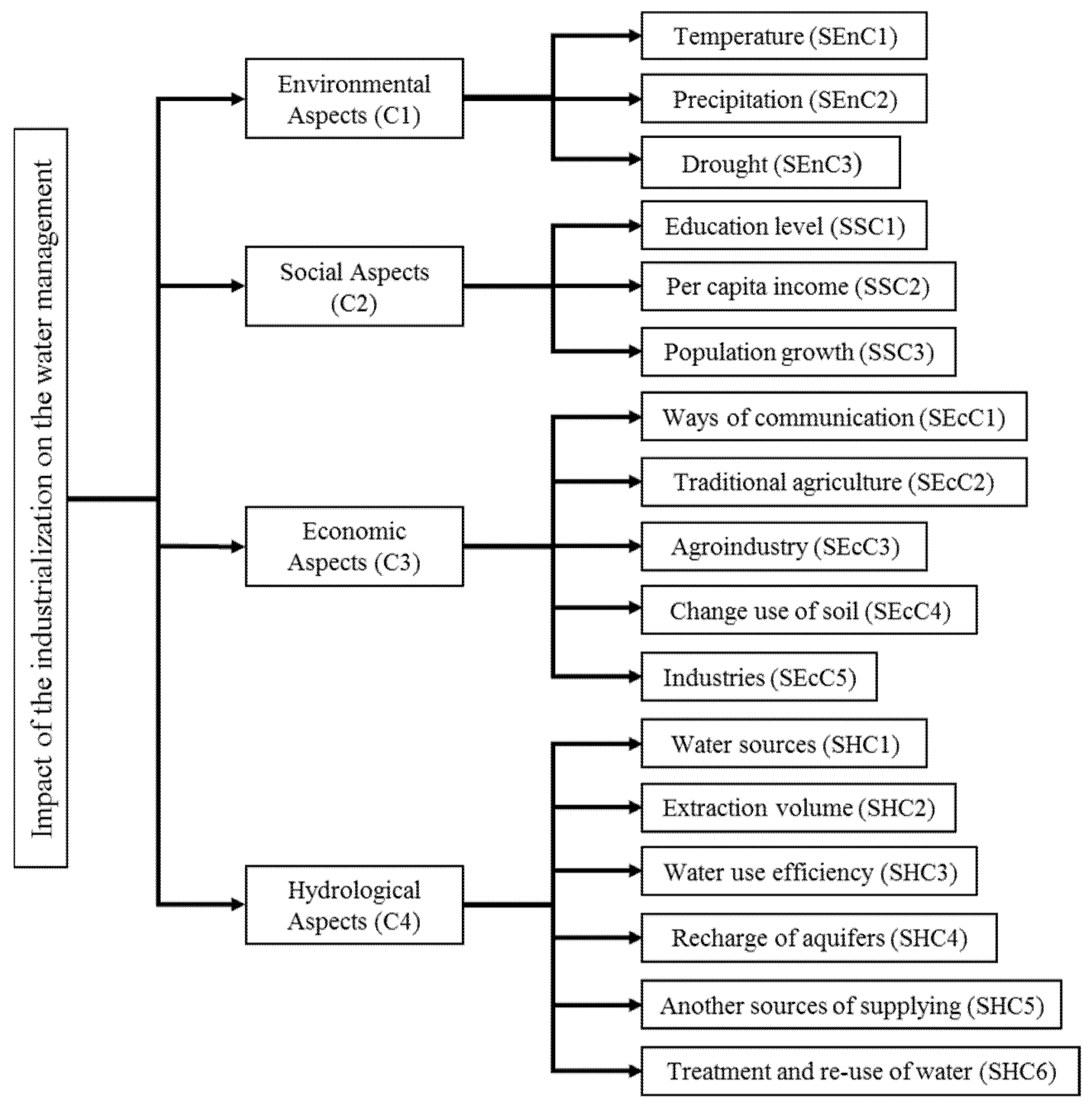3.2. Application of FL
In the case of FL, its application was based on four points for each parameter:
- (1)
Obtaining data on the evolution or current situation of each of the parameters (sub-criteria defined in the decision tree), through bibliographical searches in various official sources in order to define the evolution over time of each parameter, or to know its current situation.
Thus, we set out to investigate whether the arrival of companies in the municipalities of interest has caused any change in their situation, either by benefiting them, by keeping them relatively the same, or by aggravating their situation.
- (2)
The definition of the membership functions to quantify the membership values of the linguistic terms considered.
- (3)
Graphical representation of the membership function.
- (4)
Obtaining fuzzy values.
Furthermore, a number of considerations were made for the better handling and interpretation of the data available in each parameter:
Temperature (T): For this parameter, the Ecology Institute of Guanajuato State (IEE) predicts a possible increase in the average temperature of the state of 0.6−0.8 °C due to climate change [
25], as well as alterations on the volume and patterns of rainfall, and higher possibilities of drought, for the same reason.
In order to understand the evolution of the average temperatures, measurements were taken from 2005 to 2016, and their averages were compared at the National Water Commission (CONAGUA), against the historical average temperature registered in each municipality.
Given the relative homogeneity of the municipalities studied with this parameter, an increase of temperature could make the municipalities prone to desertification, as well as to the alteration of other important environmental variables.
Precipitation (P): According to the IEE, the rainfall patterns are expected to be altered by climate change, as well as a state-wide decrease in rain precipitation in Guanajuato, which will intensify and become more frequent, with the possible effect of floods and the overflow of the different bodies of water [
25,
38].
A similar study was conducted by CONAGUA, in the same period of time (2005−2016), measuring and averaging precipitation in the region, and these results in turn were compared to against the historical average precipitations in each municipality.
Then, based on high sensitivity of the municipalities to rain alterations and its evolution in time, we proposed ranks where a decrement of rain equal or higher to 85 mm is considered the worst possible situation, reducing progressively its impact if the decrement is lowered to 85 mm.
Drought (D): According to a study done by the IEE, climate change is expected to prolong the dry season, which will likely increase the risk of forest fires—with concomitant emission of greenhouse gasses—greater degradation and erosion of soils, among other effects [
25,
38].
For this analysis, an index of drought was proposed based on the classification elaborated by the Drought Monitor of North America (DMNA), where a zero value was assigned to days without drought, while dry days are assigned the value 1; moderate drought has a value of 2; severe drought has a value of 3; extreme drought has a value of 4, and exceptional drought has a value of 5 [
37].
In that study, the year was divided in months without drought and months with any level of drought. According to the drought level indicated, each month was multiplied by a corresponding number on the scale: if a month has only dry days it is multiplied by 1; if a month presents moderate drought it is multiplied by 2, and so on for every month within the span of the study.
Once the drought-values for every month were obtained, they were added to get the value by year and this number was used to calculate the fuzzy value for every year. Subsequently, this process was repeated yearly for a certain period in every municipality. Finally, the fuzzy values were added to obtain an average for each municipality, and this value was used in subsequent calculations.
Education level (E): It is important to know if the arrival of industries to our municipalities has caused an increment of the education level of their inhabitants, due to the need for qualified personnel in their productive processes.
This parameter was taken as the difference between the average study-grade at the national level and the corresponding average of the inhabitants of our municipalities, and it serves as the base parameter of measurement.
The methodological hypothesis is that if the difference between the national and municipal averages is positive, the lesser the education level at the latter scale is considered. This is justified by considering the national average as the minimum educational level requested for most job vacancies at these industries. If this level falls below this threshold, the possible consequence is the inability of people in these regions to be employed by these companies at a managerial or technically-skilled level.
Per capita income (Pc): Until around 2000, most of the economically active population (EAP) in the region had incomes between one and two daily minimum wages (m.w.), and was attributed to a considerable proportion of workers being employed in agricultural- and livestock-related activities.
The arrival of several companies to the region was expected to increase the income average of the population hired by them, and that this would improve the living standard of the inhabitants; it was one of the main reasons to allow industrial growth in the region.
Taking all of the above into account, we consider as viable subjects of study those workers earning 1−3 m.w., where 3 m.w. would be the minimum income to sustain a family. Thus, a Pc closer to zero means that a higher percentage of people are above the 3 m.w. mark, and that industrial growth has had a positive economic impact on the population. Conversely, values closer to 20 mean that most people are below the 3 m.w. mark, and that the impact of industrial growth has been deficient. In this last case, a change of economic policy must be implemented or at least considered.
Population growth (PG): With the arrival of heavy industry to the municipalities under study, an increase in population growth would be expected due to new employment opportunities. In turn, this would imply an increased stress on the water supply system, especially at its sources, while a population decrease would diminish this stress.
This parameter was calculated as the difference between the national population growth average and the average in the municipalities we studied. It means that if a PG < 0, it represents a municipal growth lower than the national average, and it is considered as positive; a value of PG = 0 means a growth of the population equal to the national average; and a PG > 0 means a higher growth of population in the municipalities studied, and it is considered as negative.
The comparison with national values is done so as to provide a reference framework on the growth of municipalities, where an increase in population higher than the national average means the industries are attracting more people that other regions in Guanajuato, or even other states. This situation must generate important impacts on social structure, environmental management, and hydric resources—among other factors—in the municipalities.
Commuting infrastructure (C): This parameter measures the evolution in the length of the state highway network in time, at the beginning of the industrialization in our municipalities, up to around 2000. This is relevant because highways are the main commuting means for the population, and the way in which most of the products and supplies to the industries are transported, in addition to be among the main decision parameters when deciding on the location of the companies. Thus, a value of C ≤ 0 means there was no construction of new roads, or some stretches were lost in the existing ones; other values mean there was an increase in the road network.
Traditional agriculture and agro-industry (A): This parameter was considered because, before the year 2000, the main economic activities in our municipalities were related to traditional agriculture and traditional crops such corn, wheat, soy, and others, covering most of the land-surface designated for productive activities.
However, since the year 2000, the economic importance of traditional agriculture has decreased and its crop lands have been assigned to other economic activities, such as agro-industry and industrial parks. Thereby, this parameter measures how the use of land has shifted from traditional agriculture and agro-industry over time. Both parameters were calculated as the difference in hectares of the total area sown from one agricultural cycle to another, with emphasis on the agro-industry production of different types of crops destined for export. Here, a value of A ≤ 0 means that the sown area remains unchanged or undergoes some reduction, and values of A > 0 indicate the ranges in which the sown area has increased, making no distinction between traditional agriculture and agro-industry.
Shift of use of soil (Us): It is the percentage of soil which has lost its natural cover of vegetation to be destined to other uses, like economic activities or human settlement. Its importance is that it allows to determinate if industries have caused a higher or faster loss in vegetation in our municipalities, due to the impact of industrial activities caused in the places where they settle.
Due to the great variety throughout our municipalities on the use of land, we considered data in the time span 2009−2016. To compare the changes in the use of the soil, we assigned a weight to each point considered:
*
Agricultural: It is the surface-area destined to traditional agriculture, agro-industry and artificial grassland.
| Where | If X < 100 → 0 | The agricultural surface has decreased. It has weight 0. |
| If X = 100 → 1 | The agricultural surface remains without changes. It has weight 1. |
| If X > 100 → 2 | The agricultural surface has increased. It has weight 2. |
* Settlement/Urban area: It is the sum−total of hectares destined to human settlement, urban areas, industrial parks, and industrial areas.
| Where | If 0 < X ≤ 20 → 1 | The urban area has increased at most 20%. It has weight 1. |
| If 20 < X ≤ 40 → 2 | The urban area has increased at most 40%. It has weight 2. |
| If 40 < X ≤ 60 → 3 | The urban area has increased at most 60%. It has weight 3. |
| If 60 < X ≤ 80 → 4 | The urban area has increased at most 80%. It has weight 4. |
| If 80 < X ≤100 → 5 | The urban area has increased at most 100%. It has weight 5. |
| If X > 100 → 6 | The urban area has increased more than 100%. It has weight 6. |
* Other uses: Is the surface destined to environmental conservation in the municipalities and includes forests and other types of wilderness, and bodies of water.
| Where | If X > 100 → 0 | The conservation surface has increased. It has weight 0. |
| If X = 100 → 1 | The conservation surface remains without changes. It has weight 1. |
| If X < 100 → 2 | The conservation surface has decreased. It has weight 2. |
Studying the previous values, the worst-case scenario is when agricultural surface increases (weight 2); the urban area increases by more than double (weight 6), and the conservation surface decreases (weight 2). The sum of the weights is 10. By the same token, the best-case scenario is when agricultural surface decreases (weight 0), the urban area increases at most 20% (weight 1), and conservation surface increases (weight 0). The sum of these weights is 1. The weights obtained for each municipality were used to get the corresponding FL-value.
Parks/industries (I): In this parameter we used the number of Economic Units (EU), which are all new productive units registered officially in the National Statistical Directory of Economic Units (DENUE), because the problem of separating all types of units by economic sector, year by year in each municipality of study, from 2010 to 2017, and comparing the number of EU in one year against the number of the subsequent year is too cumbersome; we instead obtained the difference between them.
In this case, a value equal to or less than zero means that no new EU were opened or that their number decreased compared to the previous year and, conversely, values greater than zero mean an increment of Economic Units with respect to the previous year.
This difference over the years was used to obtain the fuzzy value corresponding to each period (2010–2011, 2011–2012, etc.). Afterwards, these fuzzy values were added and divided by six to get a fuzzy average-value in each municipality. The fuzzy ranks were defined considering the maximum and minimum values reached in the municipalities in the appropriate time span.
Water sources (W): This aspect measures the contribution that a new water source can provide to the municipalities of study, with the aim of reducing over-exploitation of the water sources currently in use and/or of diversifying the water sources available, to fulfill current or future needs in water.
The current situation of water sources in all of the El Bajío region does not permit getting a greater volume of water from the existing sources, due to all sources available on the surface and underground being over-exploited.
For instance, the municipality of León has developed the project called “El Zapotillo” to cover domestic and industrial water needs, and the municipality of Celaya built the project called “El Realito” to supply water for domestic use.
In the rest of the municipalities, there are no plans to obtain water from traditional or alternative sources. Fuzzy ranks were defined as the percentage of water these new sources may provide, with respect to a deficit in aquifers currently exploited by municipalities.
The fuzzy ranks proposed in this work consider that a new source with a contribution of at least 20% with respect to an aquifer’s deficit has a large weight and is thus a very viable option to increase the resources of the water supply.
Water extraction (We): This parameter measures the difference between the refill rate and extraction rate in a water source as a percentage; the closer it is to 20%, the more engaged the aquifer is considered to be. The fuzzy ranks are proposed considering the values of extraction and refill showed in documents of CONAGUA, indicating the current situation of over-exploitation of the aquifers.
Use of water efficiency (Ue): The higher the value of this parameter, the greater efficiency in the use of water, and the lower the extraction volume from a source, thus reducing the impact on the water sources. It is defined as the volume of water used in different sectors such as agricultural, industrial, and domestic, with their correspondent efficiency of application, meaning the volume of water delivered to the end-user with respect to the volume of water extracted.
These fuzzy ranks were defined considering the agricultural use, which is the main use of water in Guanajuato, with more than 80% of the total of water extracted, and also the end-user which overall has the lowest application efficiency, at about 30–40% in general, with a peak efficiency of 63–65% rising up to 90% depending on the type of irrigation used in each case [
39]. For domestic users, the best values reach an efficiency of 80% or greater, especially in buildings with a more up-to-date infrastructure and distribution systems. However, when the infrastructure is not in appropriate operating conditions, this efficiency can be much lower. For the industrial sector there was not enough available information to compute an accurate efficiency percentage.
Aquifer refill (R): It is the difference between the volume of refill of the aquifer and the volume of extraction, where ideally, the refill rate should be higher than—or at least similar to—the extraction rate, allowing a balanced use of the aquifer.
With regard to the fuzzy ranks, the higher the difference between extraction and refill, the worse the aquifer’s situation is considered to be, particularly if this value is greater than 5%, given the current problematic of over-exploitation of these bodies of water. This aspect should be a priority for the authorities because aquifers are the main source of supply for all municipalities studied, and these water sources have several deficiencies in this regard [
40].
Other sources (Os): This is the percentage of volume that the new water source will contribute with respect to the volume obtained from traditional exploited sources, such as rivers, lakes, aquifers, etc. These are currently considered among the first options when the more traditional ones are at full capacity.
The current hydric situation in the area makes rainwater harvesting the only non-traditional option currently available. However, the irregularity of rainfall, the lack of appropriate facilities for collection and storage, the poor support and promotion from authorities, and the fact that this option would be useful only during the rainy season (June–September), make its application difficult in the short term.
Considering the short duration of the rainy season, the fuzzy ranks consider the best situation to be when volume of rain can cover 30% or more of the annual water consumption volume in an average house, according CONAGUA’s average rain values obtained during a long timespan in every municipality of study, in all cases of 25 years or higher.
CONAGUA has developed technical guidelines to build systems for rainwater harvesting for domestic purposes [
41]. In this case, taking [
42] as a reference, the calculation is considering that only 10% of the houses in the municipalities of study will adopt this technology. Our diffuse ranks were computed, and if 100% of houses implemented this alternative, all values relative to the contribution of this method would increase tenfold.
Treatment (Tr): It is the relation between the capacity of currently active treatment plants and the current volume of human-generated wastewater processed by them. This is relevant because a proper network of such plants might decrease the pollution of water bodies, thus increasing the volume of available resources.
In this case, if the volume treated is close to the installed capacity, we must consider that a large number of users are connected to this treatment system, and that a great volume of wastewater is treated before it is released into receptor bodies.
Conversely, if the output-volume of these plants is reduced, equal or lower than 10%, compared to their nominal capacity, we conclude that not many end-users are connected to this system, and so a large volume of wastewater is released into receptor bodies, thus polluting them.
The fuzzy ranks were defined based in the percentage of treatment of wastewater in every municipality, where zero indicates the absence of treatment facilities, and the rest of the values are indicators that represent the level of treatment-volume considering the values in all of the municipalities.
Reuse (Re): The reuse of water is the percentage of wastewater treated for its later use on different activities to replace the use of fresh water, which is related with the parameter of Treatment, because the higher the volume of wastewater is treated, potentially the more treated water will be available to be used for consumption (either human or industrial).
The fuzzy ranks were established considering the volume of water reused by the municipalities, where zero indicates the absence of reused water and the rest of values indicate the increase of water reused overall. This parameter has a high potential of relevance because a well-implemented treatment system is a viable option to reduce the exploitation of the water sources.
As explained in
Section 3.2, the next step was to conduct a bibliographic search of different official sources for each of the parameters explained above, and in this way observe their behavior from the beginning of the arrival of industries in the municipalities of study up to the latest year available prior to the elaboration of this article.
In this way, four types of graphs were identified according to their starting and ending points (see
Figure 3), and it was considered that it was more convenient to consider that the best situation of the parameters would be when their membership value was equal to 1 or as close as possible to it, while values equal to zero or close would indicate increasingly alarming levels of deterioration.
Thus, Chart A indicates that the value of the parameter starts from values considered optimal by reaching membership value 1, and from a certain point onward there begins to be a deterioration of the conditions for that particular parameter until the parameter reaches a number located at the zero membership value, at which the worst conditions established in the FL are reached for that case.
Chart B represents the conditions opposite to those on Chart A, since it starts with values defined as deficient, and from a certain point onward the conditions begin to improve progressively, until a number located at membership value 1 is reached, from which the rest of the values are optimal for the parameter.
For Charts C and D, the same reasoning is followed as in Charts A and B, from which they are derived, with the difference that their start is indicated by a single value from which the rest of the values would show an improvement or progressive deterioration of the relevant parameter.
Once the chart types were defined, the corresponding membership functions were developed, which were programmed using the statistical software R to facilitate and accelerate the computation of results, and in which the values obtained from the bibliographic search were entered for each parameter.
When the computational analysis was completed, the corresponding fuzzy values and linguistic variables were obtained in each case, resulting in a perspective on the type of impact caused by the establishment of industries in the municipalities we study.
